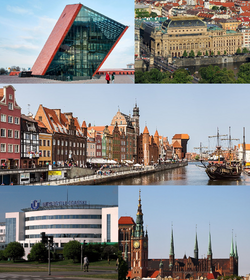Dyńsk: Difference between revisions
No edit summary |
No edit summary |
||
| Line 3: | Line 3: | ||
|native_name = | |native_name = | ||
|native_name_lang = <!-- ISO 639-2 code e.g. "fr" for French. If more than one, use {{lang}} instead --> | |native_name_lang = <!-- ISO 639-2 code e.g. "fr" for French. If more than one, use {{lang}} instead --> | ||
|settlement_type = | |settlement_type = Revolutionary city | ||
|image_skyline = Dynsk_collage.png | |image_skyline = Dynsk_collage.png | ||
|image_size = 250px | |image_size = 250px | ||
Revision as of 19:43, 7 August 2020
Dyńsk | |
|---|---|
Revolutionary city | |
 From top, left to right: the Miersan Museum, the Romauld Theatre, the waterfront skyline, the University of Dyńsk, the town hall. | |
| Country | East Miersa |
| Department | Dyńsk ASFC |
| Founded | 8th century |
| Charter granted | 1029 |
| City status | 1261 |
| Government | |
| • Type | Council democracy |
| • Body | Dyńsk Council |
| • Chairperson | Witołd Sobolewski |
| Population (2020) | |
| • Total | 3,312,542 |
| Demonym | Dyński |
Dyńsk is the largest and de facto capital city of the Miersan Socialist Republic. The city sits on Lake Croix, and as of 2020 has a population of over 3.3 million. It is the capital of the department of Greater Dyńsk, and is located in the historical voivodeship of Morskie. It remains one of the most prominent cities on the Eleutherian Lakes, second in size only to Rayenne. It has historically been a major port, important to east-west trade in Euclea.
The city was first founded in the 8th century, and soon grew into a major tradeport for the crown of Wybrzeże. Dyńsk was granted a town charter in 1029, and after the unification of the Three Crowns, it was granted city status by Romuald the Bold in 1261. During the Miersan Interregnum, the city was a royalist stronghold, and remained in support of royalist forces, though came under the control of the Miersan Republic on a number of occassions. The city was part of the territory ceded to Gaullica in 1638 following the conclusion of the War of the Miersan Succession. Under Gaullican rule, the city remained a major port, but the value of trade across the Eleutherians decreased over time, and the city declined. It experienced a revival in the 1800s, benefiting from the industrial revolution and growing into a manufacturing hub focusing on steel production. Following the Great War, the city saw a mass expulsion and persecution of local Gaullican speakers, and became a key centre for the 1936 general strike which, in part, led to the Godfredson Plan.
Dyńsk is ranked highly in terms of quality of life and living standards, and has a local economy and income level far higher the East Miersan average. The city is home to the University of Dyńsk, the Romauld Theatre, the Miersan Museum and the All-Faiths Cathedral, among other landmarks.
